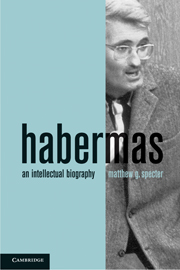Book contents
- Frontmatter
- Contents
- Acknowledgments
- HABERMAS: AN INTELLECTUAL BIOGRAPHY
- Introduction
- 1 The Making of a ′58er: Habermas's Search for a Method
- 2 Habermas as Synthesizer of German Constitutional Theory, 1958–1963
- 3 1961–1981: From the “Great Refusal” to the Theory of Communicative Action
- 4 Civil Disobedience, Constitutional Patriotism, and Modernity: Rethinking Germany's Link to “the West” (Westbindung), 1978–1987
- 5 Learning from the Bonn Republic: Recasting Democratic Theory, 1984–1996
- Conclusion
- Bibliography
- Index
1 - The Making of a ′58er: Habermas's Search for a Method
Published online by Cambridge University Press: 05 June 2012
- Frontmatter
- Contents
- Acknowledgments
- HABERMAS: AN INTELLECTUAL BIOGRAPHY
- Introduction
- 1 The Making of a ′58er: Habermas's Search for a Method
- 2 Habermas as Synthesizer of German Constitutional Theory, 1958–1963
- 3 1961–1981: From the “Great Refusal” to the Theory of Communicative Action
- 4 Civil Disobedience, Constitutional Patriotism, and Modernity: Rethinking Germany's Link to “the West” (Westbindung), 1978–1987
- 5 Learning from the Bonn Republic: Recasting Democratic Theory, 1984–1996
- Conclusion
- Bibliography
- Index
Summary
Habermas's critical reconstruction of the meaning of the eighteenthcentury Enlightenment for twentieth-century (and twenty-first-century) moderns is one of his enduring contributions. Habermas's first major work, The Structural Transformation of the Public Sphere (Transformation hereafter), is rightly seen as marking a break with the negative view of the European Enlightenment represented by Theodor Adorno and Max Horkheimer's 1947 cri de coeur, The Dialectic of Enlightenment. Transformation is Habermas's celebrated account of the transformation of the active, critical debating publics that existed in the era of the European Enlightenment into the passive, managed citizenry of the postwar welfare state. While the first half of Transformation traces the historical rise of a “bourgeois public sphere” of rational deliberation in the salons, masonic lodges, and coffeehouses of Europe, the second half of the work describes the decline of this sphere to the point of near extinction. West Germany's public sphere was in eclipse, Habermas concluded. His diagnosis was that it had been occluded by the interpenetration of state and society. The task of Critical Theory as articulated in Transformation was to reinvent the public sphere that once had tamed the Leviathan of the absolutist state. Although Habermas's Transformation shared Adorno and Horkheimer's cultural pessimism about the stultifying effects of mass communication, it also demonstrated a countervailing interest in the immanent critique of liberal ideals.
- Type
- Chapter
- Information
- HabermasAn Intellectual Biography, pp. 27 - 58Publisher: Cambridge University PressPrint publication year: 2010

